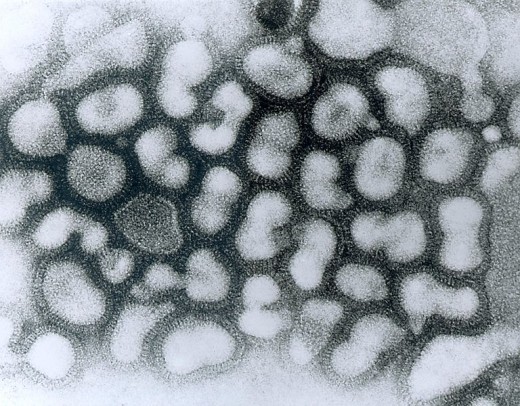What is Influenza
It's a Virus
Nineteenth Century Viral History
Influenza is a virus. A virus (Latin for poison) is not made of cells, but rather is made up of some of the components of cells. A virus can only reproduce (replicate) inside of cells by "robbing" the cell of it's reproductive chemistry. Thus a virus can only reproduce by invading a cell and "stealing" parts of that cell to reproduce (see graphic below micrograph).
In 1884, a French microbiologist named Charles Chamberland invented a filter (much like a coffee filter) with pores smaller than bacteria. By straining a solution containing bacteria through the Chamberland filter he could trap the bacteria in the filter and remove it from the solution.
The filter is essential a closed ceramic tube without the glaze. Liquids are strained through a Chamberland filter under pressure. These filters are also used to purify water.
In 1892 a Russian biologist named Dmitry Ivanovsky used this Chamberland Filter to study a pathogen infecting tobacco. This was later named the tobacco mosaic virus. Ivanovsky's experiments involved crushing tobacco leaves and extracting the fluid from them. He was able to show that these extracts were still capable of infecting tobacco plants after the bacteria were filtered out, thus proving that something other than bacteria was the cause of this plant pathogen. At the time Invanovsky was convinced that the toxin was a liquid produced by bacteria, but small enough to pass through the filter.
In 1898 a Dutch microbiologist Martinus Beijerinck repeated Invanovsky's experiments and determined that the infectious agent was something previously unknown to science. Beijerinck observed that the agent reproduced, but only in the presence of healthy cells. Unfortunately, his experiments were not able to determine what made these "particles." Beijerinck referred to the substance as contagium vivum fludum (soluble living germ) and introduced the word "virus" though he still didn't quite know what it was. Beijerinck was convinced that the "virus" was a liquid since it passed through filters and bacteria did not.
In 1899, Friedrich Loeffler passed the agent of foot-and-mouth disease (aphthovirus) through a Chamberland Filter and diluted the result. This experiment ruled out the possibility of a toxin because of the high dilution. He also determined that the agent could reproduce.
The French-Canadian microbiologist Félix d'Herelle described an agent that when added to a petri dish containing bacteria, would kill that bacteria. He discovered that when diluted this agent in suspension (liquid) rather than killing all the bacteria, formed discrete areas of dead bacteria. By counting the areas of dead bacteria and using the dilution strength as a multiplier d'Herelle was able to calculate the number of viruses.
By the end of that century viruses were defined by how infective and filterable they were. By now it was also known that a virus had to have a living cell as host to replicate.

Twentieth Century Viral History
In 1931, pathologist Ernest William Goodpasture grew influenza and several other viruses in fertilized chicken eggs. This method is still used today to produced viruses and vaccines.
Also in 1931 German engineers Ernst Ruska and Max Knoll were able to photograph the first images of viruses via an electron microscope, a new invention at that time.
In 1935 American virologist Wendell Stanley found that the tobacco mosaic virus was mostly made up of protein. Shortly after the virus was broken up into it's constituent parts of protein and Ribonucleic Acid (RNA).
In the same year, Heinz Fraenkel-Conrat and Robley Williams separated the constituent parts of the purified tobacco mosaic virus RNA and its protein coating. They were able to show that these component parts of the virus could self-assemble and form functional viruses. This suggested how viruses reproduced in healthy cells.
In 1949 John F. Enders, Thomas Weller, and Frederick Robbins grew the polio virus in human embryo cells. This was the first time a virus was successfully grown without using animal tissue or eggs. This research enabled Jonas Salk to make an effective polio vaccine.
Viral Discoveries
From the 1950s on viruses were constantly being discovered. There were two thousand distinct viruses discovered during this time including:
- Bovine Virus
- Hepatitus B
- Influenza A & B
- Human Immunodeficiency Virus
It is still unknown how viruses orignally came about, but there are three competing theories.
Regressive theory:
Viruses may once have been smaller cells that invaded and reproduced
inside larger cells. Over time components of the virus "cell" were lost
since they were not needed. The result was a "particle" that was once a
cell, but could only replicate inside a living cell. Two bacteria,
rickettsia and chlamydia, can only replicate inside a living cell
unlike other bacteria which can reproduce outside of cells.
Cellular origin theory:
Viruses may have evolved from fragments of RNA or DNA. These fragments
may have broken off from larger organisms. These fragments were
discovered in maize by Barbara McClintock in 1950.
Coevolution theory: Viruses may have evolved from complex molecules of protein and ribonucleic acid
alongside cells that first appeared on earth. In this theory the
viruses would have been dependent upon cellular life, co-evolving right
along with cellular life.

How a Virus Replicates
Once in the host body, the virus travels through the bloodstream until it finds a healthy cell. it then attaches to it via an "H" protein. This "H" protein on the surface of the virus then coaxes the wall of the healthy cell to open. It then inserts itself into the cell. Within the virus is the genetic code for influenza. e.g. instructions on how to reproduce.
The healthy cell is now hijacked.
The virus now instructs the healthy cell to give up it's RNA and proteins, effectively making it a virus factory. When the number of replicated influenza viruses reach a critical point the healthy cells bursts open releasing the reproduced viruses into the bloodstream. These newly created viruses then move on to other healthy cells and the entire process is repeated.
By this process it is possible that one virus "particle" can reproduce itself hundreds of times in a single healthy cell. With hundreds of copies, each copy seeking out another healthy cell, it does not take long for an infection to overwhelm the immune system.
Essentially a virus is capable of invading a cell, reproducing itself hundreds of times within that cell, and then causing cell death by bursting the walls of that cell. The now free virus copies are able to move on to more healthy cells and repeat the process.
It's Alive!
Well, maybe not.
There is still substantial debate about whether or not viruses are actually a form of life.
Some scientists feel that because viruses contain RNA and other organic compounds that they are indeed a life form. Others see them as simple organic structures that can interact with living organisms. Those scientists in the non-living camp refer to them as "organisms at the edge of life."
Although viruses have genes they do not have a cell structure like other living organisms. Viruses do not have a metabolism (no mitochondria) either and require a host cell to reproduce. Since viruses hijack existing structures within living cells to replicate (make copies) and do not use cell division to reproduce they are seen by some as a structure similar to crystals.
Treatment
Because a virus coaxes a healthy cell into becoming a factory, it is difficult if not impossible to eliminate them without using highly toxic drugs. These drugs have an adverse effect on healthy cells as well.
Also, because a viral infection involves invading (and hiding within) healthy cells, antibiotics are ineffective against them.
For this reason the safest way to deal with viral diseases is by prompting the body to raise an immune response prior to live infection. To do this, dead viruses are introduced via vaccination prompting the body to recognize, seek out, and destroy the unique proteins that stud the surface of the virus.
Update Availability
October 7, 2009
The Swine Flu nasal vaccination is
now available in Indiana, Illinois and Tennessee. These states must
share the seven (7) million doses available. The injection form will be
available next week.
Although the timeline originally called for all states to have access to an injectable vaccine by mid-October, this time-line seems to have slipped. Regardless, the first people to be offered the vaccine will be health-care workers.
The best source of availability information for your city and/or state will be print, radio and television media.
October 16, 2009
Availability
figures are that only 29 to 30 million doses of the dead Swine Flu
virus vaccine will be available by the end of this month 40 million was
the original target by the middle of the month e.g. now.
October 24, 2009
The Centers for Disease Control (CDC) now project that Swine Flu vaccine will be widely available by mid-month November.
Google Swine Flu Vaccine Locator
- Google's Interactive Swine Flu Vaccine Locator
Use this interactive map to locate Swine Flu vaccine near you.
Flu Series Links
- What is Influenza
Nineteenth Viral Century History Influenza is a virus. A virus (Latin for poison) is not made of cells, but rather is made up of some of the components of cells. A virus can only reproduce (replicate) inside... - Pregnancy, Swine Flu, Prevention and Treatment
In the Past During the 1918~1919 Spanish Flu pandemic, men who were exposed to flu in the womb were twenty three (23%) percent more likely, than the rest of the population, to develop heart disease after the... - Swine Flu Vaccine Dosing
As of October 15, 2009 we are still a few weeks away from all states having an injectable vaccine. However, nasal (live virus) vaccines are now available in most states. This hub will discuss which version...








